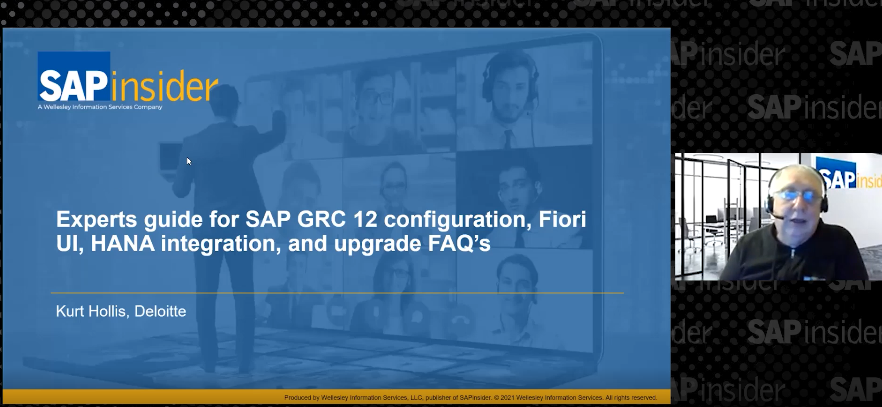Learn about the processes, configuration, and usage related to both dynamic and fixed benefits eligibility conditions in the SAP ERP HCM Benefits module. If a non-SAP system provides the time capture functionality, then infotype 2001 (attendance) has to be populated with the attendance hours for the dynamic eligibility functionality to work. Discover how to configure dynamic and fixed eligibility conditions with attendance hours being captured in SAP ERP HCM.
Key Concept
An infotype audit trail report is created to track the following:
- What changes are executed by the users
- Who has executed the changes
- When the changes have been executed
Any changes made to HR master data can be monitored by configuring an infotype audit trail report.
The Benefits module, which is a key SAP ERP HCM module, integrates with both the Time and Payroll modules. Within organizations the eligibility conditions can vary based on the grouping of employees. Some examples of employee groupings are:
- Regular or permanent employees
- Temporary employees
- Expatriates
- Students
- Part-time employees
There are two eligibility conditions for employees working in an organization; both of these can be configured in SAP ERP HCM:
- Fixed eligibility conditions (i.e., employees who complete six months of work from their hire date are eligible for benefits; these conditions are time bound and are, in this case, fixed by the number of months).
- Dynamic eligibility conditions (i.e., the measurement of time for the condition is dynamic and not fixed; the time frame may be total number of hours worked during the time evaluation period. For example, a part-time employee may take a year to reach the eligibility requirements of working 1,000 hours, but a full-time employee may meet the requirement in six months).
I show you how to configure these methods and the benefits of each.
Fixed Eligibility Conditions
The main conditions for fixed eligibility patterns are based on a fixed waiting period for enrollments (e.g., all full-time employees are eligible to receive insurance six months after their date of hire).
Dynamic Eligibility Conditions
The main conditions for dynamic eligibility patterns are based on ongoing waiting periods for dynamic eligibility enrollment conditions based on the actual hours worked (e.g., all full-time employees are eligible to receive insurance after they have worked for their company for 1,000 hours).
Note
The dynamic eligibility condition is for employees who are hourly based. These employees can work full- or part-time.
Fixed Eligibility Conditions: Integration Points
For this condition the only integration point is between the SAP ERP HCM Personnel Administration and Benefits modules. The system determines the fixed waiting period based on the hire date of the employee. The system then uses the fixed waiting period to calculate the eligibility condition. The hire date is stored in infotype 0000 (action). Once the employee works six months (from his or her date of hire), infotype 0041 is dynamically populated with the eligibility date.
Fixed Eligibility Condition Configuration Requirements (Month-Based Waiting Period)
You must configure the system with the following:
- Date type (infotype 0041)
- Adjustment reason (infotype 0378)
Configure the Date Type (Infotype 0041)
Configure the system as follows as this is required to capture the completion date of the compulsory waiting period. As soon as the employee completes the required waiting period, this date type is populated. In my example, this period is defined as six months from the date of hire. Follow IMG menu path Benefits > Flexible Administration > Program > Employee Eligibility > Dynamic Eligibility > Define Date Types or table V_T548 (Figure 1). Click the New Entries button to create the new date type and then click the save icon  . In my example, I create a date type of 91 with a six-month completion period.
. In my example, I create a date type of 91 with a six-month completion period.

Figure 1
Create a new date type with a fixed eligibility condition
Configure the Adjustment Reasons (Infotype 0378)
The configuration for adjustment reasons is required to capture the reasons for enrollment on completion for the required waiting period. Follow IMG menu path Personnel Management > Benefits >Flexible Administration > Benefits Adjustment reasons > Define Benefit Adjustment Reasons (Figure 2). In this step you configure the adjustment reasons for enrollment based on the completion of a set waiting period. In my example, the employee is eligible to be enrolled in the plan in six months. Click the New Entries button and enter LTDI in the Adjust. reason column and Elig for LTDI Plan in the Text column (LTDI stands for long-term disability plan).Then click the save icon to save the newly created entry.

Figure 2
Create the benefit adjustment reasons
After creating the adjustment reasons, you need to create the adjustment permissions. Adjustment permissions determine which plan types employees can enroll in via the adjustment reasons. In my example, the employee is eligible for long-term disability in six months. Follow IMG menu path Personnel Management > Benefits > Flexible Administration > Benefits Adjustment reasons > Define Benefit Adjustment Permissions or table V_74HB (Figure 3).
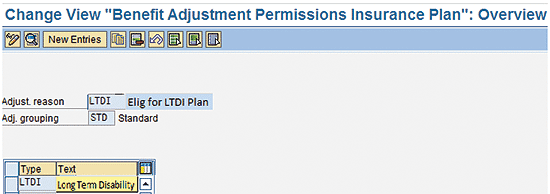
Figure 3
Create the adjustment permissions
In Figure 3, click the New Entries button, and the bottom part of the screen appears. In the Adjust. Reason field, choose LTDI from the drop-down options (which are based on your previous configuration). In the Adj. grouping field, enter STD (the standard SAP system grouping), and in the Type and Text columns, add the benefit plans that need permission for this adjustment reason (LTDI and Long-Term Disability, respectively). Click the display icon  . You now can select different permissions for the benefit plan based on the adjustment reasons. Figure 4 is the overview of the configuration for the permissions granted.
. You now can select different permissions for the benefit plan based on the adjustment reasons. Figure 4 is the overview of the configuration for the permissions granted.

Figure 4
Configure the permissions
In above configuration step, you configure permissions to the system to change the benefits plan, add a plan, delete a plan, or change the plan’s coverage for employees based on the adjustment reasons. Figure 4 shows the different permissions being granted through the configuration. Now that you’ve configured the adjustment reasons, you need to link them to the date type.
Link the Date Type to the Adjustment Reasons
In this step you link Date Type (i.e., six months from date of hire) to the Adjustment reason. This link integrates the waiting period and the adjustment reasons. Follow IMG menu path Benefits > Flexible Administration > Program > Employee Eligibility > Dynamic Eligibility > Assign Dynamic Eligibility Conditions to Date Types (Figure 5).
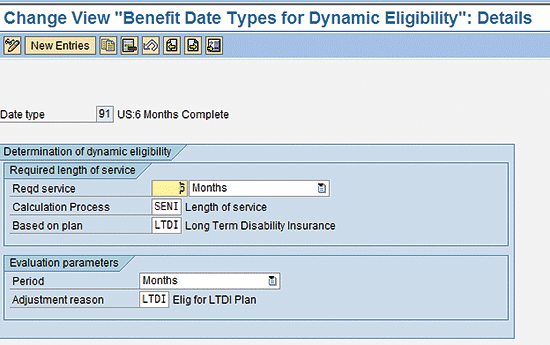
Figure 5
Assign the condition to the date type
In Figure 5, choose 91 from the drop-down options as your Date type (this is the value you previously configured for infotype 0041). To set the dynamic eligibility conditions, you need to define the following parameters:
Required service: Enter 6 and choose Months from the drop-down options in the Reqd service field.
Calculation Process: Choose SENI from the drop-down options (this is a calculation process delivered by the SAP system, and it calculates six months from the date of hire).
Based on plan: Choose LTDI from the drop-down options (LTDI is the adjustment reason you configured earlier).
Period: Choose the drop-down value Months (i.e., the waiting-period condition is based on months).
Enroll in a Fixed Eligibility Benefit Plan
Figure 6 shows the process for enrolling employees in an SAP benefit plan based on fixed eligibility conditions.

Figure 6
Fixed benefit eligibility process steps
Now I show you how to do this in the SAP system with an eligibility waiting period condition of six months.
Step 1. Create a Six-Month Eligibility Condition for New Employees
In this step you create a month-based eligibility condition for a new employee (Figure 7). In my example, I hired a new employee via transaction code PA40. Click the action infotype (0000) and you can see the employee’s hire date is 18.01.2013, and he is eligible for the benefit plan after six months of employment, which is 18.07.2013 (Figure 8).
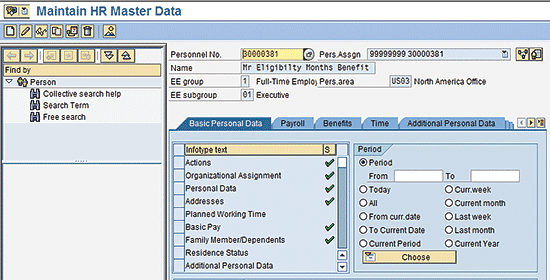
Figure 7
An employee with a fixed eligibility benefit condition
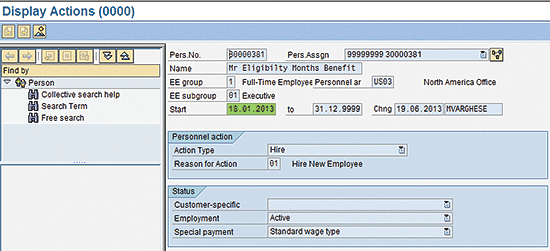
Figure 8
Verify the employee’s hire date
In Figure 8, in display mode, you can verify the hire date for the new employee is through infotype 0000; note that the start date is 18.01.2013.
Step 2. Run an Eligibility Check Through Report HRBEN0047
The next step is to make sure that the employee is eligible for the benefit. You do this via report HRBEN0047. Execute the report by typing HRBEN0047 in the SAP system’s command bar (Figure 9), then press Enter and create a new session to execute the report.

Figure 9
The command bar to execute the eligibility check
In the next screen (Figure 10), you enter the right values for the report. All the values are part of the design. In my example the Benefit area is AA, the 1st Program Grouping is ALLE, and the 2nd Program Grouping is REGU.

Figure 10
Execute report HRBEN0047
To test the eligibility condition for the employee hired, enter the employee’s ID number (30000381) in the Personnel Number field and click the execute icon  . The results for this report appear in the next screen (Figure 11).
. The results for this report appear in the next screen (Figure 11).

Figure 11
Results for report HRBEN0047
Report HRBEN0047 displays infotypes 0041 and 0378, both of which were created for the employee. This means that the employee is eligible for the benefit plan. You can verify the infotypes via transaction code PA20 for the employee.
Figure 12 is the display screens for infotypes 0041 and 0378. It shows that both infotypes were created on 18.07.2013.

Figure 12
Infotypes 0041 and 0378 were created dynamically
Step 3. Enroll the Employee in the Benefit Plan
Now you can enroll the employee (30000381) into the plan using transaction code HRBEN0001. Enter HRBEN001 in the command bar (Figure 9). In the benefit enrollment screen (Figure 13) select the benefits for the employee and enroll him.

Figure 13
Select the benefit type and enroll the employee
In the Direct selection tab, enter the employee’s personnel number and click the execute icon. This action creates the screen on the right of Figure 13. Click the Enroll button to complete the enrollment of the employee into the plan. The next screen (Figure 14) confirms that the employee is enrolled in the plan.

Figure 14
Report HRBEN0001 confirms that the employee is enrolled in the plan
Dynamic Eligibility Condition Configuration Requirements (Hour-Based Waiting Period)
For this condition the integration point is between Personnel Administration, Time Management, and Benefit Administration. The SAP system determines the eligible hours for the hour-based waiting period from the number of hours captured on infotype 2002 (attendance). Once the employee completes the required hours from the hire date (1,000 hours in my example), infotype 0041 is dynamically populated with the eligibility date.
The following infotypes must be configured:
- Time transfer specification (infotype 2012)
- Date specifications (infotype 0041)
- Adjustment reasons (infotype 0378)
The basic configuration of infotype 2012 is required to capture the time-accumulated attendance hours toward the dynamic eligibility condition. This condition is based on the completion of the required hours by the employee before he is eligible for the benefit plan.
The configuration of infotype 2012 transfers the attendance hours from infotype 2002 (attendance) to infotype 2012 for calculating the dynamic eligibility condition. So, whenever time evaluation is executed, infotype 2012 is populated with the hours from infotype 2002.
To configure the time transfer infotype follow IMG path Time Management > Time Evaluation > Time Evaluation with Clock Times > Processing of Balances > Time Transfer > Define Time Transfer Types. In the screen that appears click the New Entries button to create a new time transfer type (Figure 15).

Figure 15
Create the time transfer type (table V_T555P)
In my example, I have created $301 as the transfer type (subtype of infotype 2012), and you want to transfer to the attendance hours (infotype 2002) captured to infotype 2012. Enter the required information in the screen in Figure 15 and click the New Entries button.
Next, you create the rule that defines how many hours an employee needs to complete to be eligible for the benefit plans. Follow IMG path Time Management >Time Evaluation >Time Evaluation with Clock Times >Time Transfer >Define Time Transfer Types > Define rules for transfer to time types. Click the New Entries button to create the time transfer type rule (Figure 16).

Figure 16
Rules for time transfer type (table V_T555J)
In my example, the condition is that 1,000 hours have to be completed for employees to be eligible for the insurance benefit plans. In Figure 16 the time type drop-down option is $301, which was configured in the earlier step. The Time type text field is also a drop-down field; in this case Ben 1000 Hours. Enter a + sign in the +/– column, 100 in the % column, and the minimum and maximum eligibility hours in their respective columns (both 1000 in this example).
Map the Attendance Infotype and the Time Transfer Specification Infotype
Now that you have created your new eligibility rule, the next step is to map between the attendance type (infotype 2002) to the time transfer specification type (infotype 2012) in table T555Y or T555Z. When you execute time evaluation in the SAP-delivered Time Management solution, the mapped attendance type (2002) updates the mapped time transfer specification type (2012). Therefore, when you execute time evaluation, the hours recorded in infotype 2002 are transferred to the mapped time transfer specification type (2012).
Configure the Adjustment Reasons and Create the Permissions
The next step is to configure the adjustment reasons and create the permissions for your new rule. This configuration is required to capture the reason for enrollment on completion of the required number of hours. Follow IMG path Personnel Management > Benefits > Flexible Administration > Benefits Adjustment reasons > Define Benefit Adjustment Reasons (Figure 17).

Figure 17
Create the new benefit adjustment reasons
To create the new adjustment reason, click the New Entries button. Enter INSU in the new Adjust. reason column and Elig for Insu Plans in the Text column. Click the save icon. INSU—eligible for insurance plans—is for the dynamic eligibility condition. On completion of the required work hours, the employee is eligible to enroll in the plans.
After you create the adjustment reasons you need to create the adjustment permissions. The adjustment permissions determine what plan types can be used for enrollment through the adjustment reasons. Follow IMG menu path Personnel Management > Benefits > Flexible Administration > Benefits Adjustment reasons > Define Benefit Adjustment Permissions, or use table V_74HB_B through transaction code SM30 (Figure 18).

Figure 18
Create the adjustment permissions for the insurance benefit
Choose INSU from the Adjust. Reason drop-down field (from your previous configuration for the adjustment reason). The Adj. grouping field already has STD entered. This is the standard SAP system grouping, and it is what you want to use.
You can add the benefit plans that need permissions for this adjustment reason in the Type and Text columns. Some examples of common options that employees are eligible for after completing the required number of hours are:
- AD&D: Accidental death and dismemberment insurance
- DLIP: Dependent life insurance plans
- LIFE: Basic life insurance plan
- SLIP: Supplemental life insurance plan
The final step for creating the adjustment permission is to configure it. Click the New Entries button (Figure 18). In my example shown in Figure 19 I give permission for the plan type AD&D. In the Authorizations Plan and Detail sections select the appropriate check boxes. Once you’ve made your selections, click the save icon. You can add permissions to the other plans by following the same steps.

Figure 19
Make changes to the permissions
Through this configuration you are giving permission to the plan to complete one or more of the following tasks:
- Change plan
- Add plan
- Delete plan
- Change coverage
Figure 20 lists all the plans that have been added through this configuration and provides you with an overview of the different permissions that you have given to the adjustment reasons.

Figure 20
Review and configure the adjustment permissions
Configure the Date Specification Type (Infotype 0041)
Now you need to configure the date specification type to capture the completion of the required hours. Once configured, as soon as the employee completes the required hours, this date type is auto-populated. In my example, infotype 0041 is populated with the 1000 hours date type requirement. Follow IMG menu path Benefits > Flexible Administration > Program > Employee Eligibility > Dynamic Eligibility> Define Date Types or use table V_T548Y (Figure 21).

Figure 21
Enter the new date type (infotype 0041)
Click the New Entries button. In my example, I create date type 90 for 1000 hours of work. Enter the date type (90 in this example) and, in the second Date type column, the number of hours the employee has to complete to become eligible (1000 hours). Click the save icon to save your new date type.
Define and Assign the Benefit Eligibility Rule
Now you are ready to define and assign the employees who are eligible for enrollment in benefit plans after completing the required number of hours. Follow IMG menu path Benefits > Flexible Administration > Program > Employee Eligibility > Dynamic Eligibility > Define Eligibility rules (Figure 22).

Figure 22
Assign the benefit eligibility rule to the employee
In Figure 22, click the New Entries button. Enter 1000 in the Variant field and PART in the Grouping field. Select the Immediate radio button in the Enrollment section. You can enter the start and end dates as per the migration strategy. It is advised by SAP that you go to the earliest date possible to avoid data migration issues. In my example I have made the start date as 01.01.1950 and the end date is the SAP system default date, 31.12.9999.
In the Minimum working time section enter the Number as 1,000 and the Period as Years. Click the save icon. Now you have finished configuring the rules for enrolling employees in benefit plans based on dynamic eligibility conditions. Next, I show you how to do the same thing for employees based on dynamic eligibility conditions.
Enrollment in a Benefit Plan Based on a Dynamic Eligibility Condition
Figure 23 outlines the process steps for enrolling an employee in a benefit plan based on a dynamic eligibility condition. In my example, the dynamic eligibility condition is that the employee is eligible for benefits after working the required number of hours (1000).
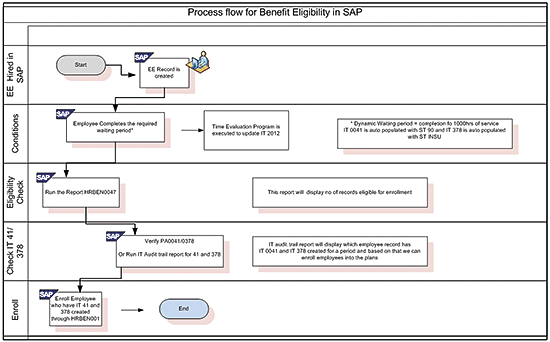
Figure 23
Dynamic benefit eligibility process
Step 1. Hire the Employee in the SAP System
In this step you are hiring an employee who has to work 1,000 hours before he qualifies for the company benefit plans. To complete this step execute transaction code PA30. The screen that appears (Figure 24) is for the hired employee (Personnel No. 30000375). The employee has a hire date of 01.05.2013 and is eligible for the benefit plans on completion of 1,000 working hours as per infotype 2002 (attendance). This is transferred to infotype 2012 when time evaluation is run. If the attendance hours are captured outside of the SAP system, you need to populate the attendance hours in infotype 2002 for this solution to work dynamically in the SAP system.

Figure 24
Hire a new employee with a dynamic eligibility condition
Step 2. Run the Time Evaluation for the Employee
The next step is to run the time evaluation for this employee (I have created 1,200 working hours in infotype 2002 for testing purposes, which is transferred to infotype 2012 when time evaluation is executed). Time evaluation can be run via transaction code PT60 (Figure 25).

Figure 25
Run time evaluation for the new employee
Enter the personnel number of the new employee in the Personnel Number field (30000375) and enter the evaluation schema created for time evaluation in the evaluation schema field (in my example I use schema /U04). Click the execute icon.
Figure 26 is the time evaluation result for the employee record (personnel number 30000375). It shows that the employee has worked 1,304 hours (1,200 hours that were just added plus an additional 104 hours from the previous pay period). This means this employee is dynamically eligible for the benefit plans.
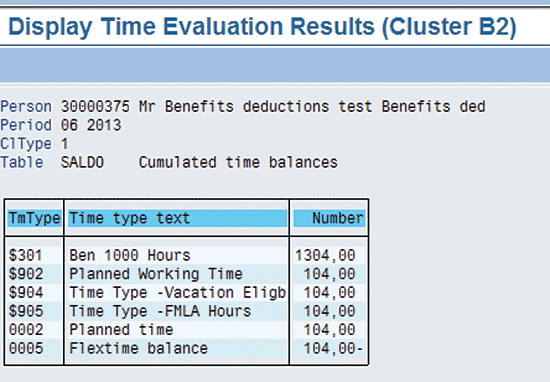
Figure 26
Time evaluation result for the employee
Step 3. Check the Employee’s Eligibility via Report HRBEN0047
To execute report HRBEN0047 type HRBEN0047 in the SAP system’s command bar (Figure 9) and press Enter. In the screen that appears, you need to populate the values for the 1st Program Grouping and the 2nd Program Grouping (Figure 27).

Figure 27
Report execution screen for dynamic eligibility check for the employee
All the field values shown are part of the design. In my example, the Benefit area is AA, the 1st Program Grouping is ALLE, and the 2nd Program Grouping is REGU. After you enter the values in these fields, click the execute icon to execute the report. In Figure 28 you see the report results for infoytypes 0041 and 0378 that were created for the employee. It shows that the employee is eligible for the benefit plan.
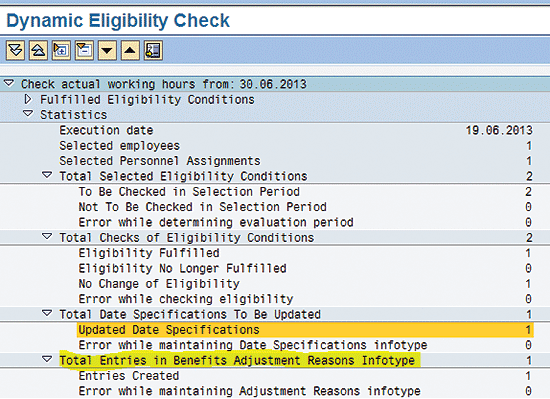
Figure 28
Dynamic eligibility check report output
Next, use transaction code PA20 to verify the infotypes for the personnel number 30000275. The screen shown in Figure 29 displays both infotypes (0041 and 0378) that were created on 20.06.2013.

Figure 29
Show both infotypes that were created dynamically
Step 4. Enroll the Employee in the Benefit Plan
The next step is to enroll the employee in the plan. Enter transaction code HRBEN0001 in the SAP system command (Figure 9) bar and press Enter. In the next screen Key in the Personnel no. (30000375) for the employee (Figure 30) and click the execute icon. This opens the Offer selection section (on the right). Click the Enroll button to complete the employee’s enrollment in the benefit plan.
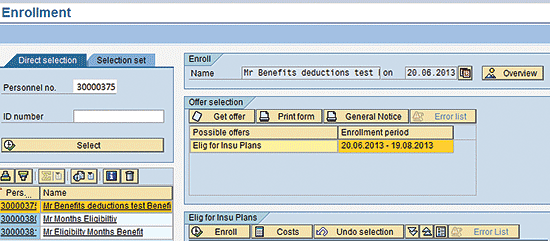
Figure 30
Enroll employee 30000375 in the benefit plan
Once the employee’s enrollment is complete, you see confirmation of the employee’s enrollment as shown in the screen in Figure 31.
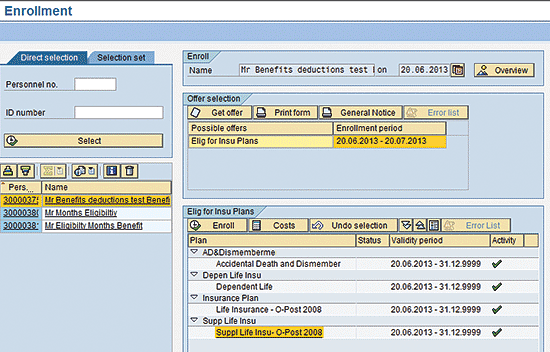
Figure 31
Confirmation that the employee is enrolled in the benefit plan
Tip!
It is not possible to run a benefit plan eligibility check for multiple employees via report HRBEN0047 as this results only in a report of the number of records created for infotypes 0041 and 0378. This report does not identity the specific employee for whom these infotypes were created.
In my example I was able to create the eligibility condition for an employee for each of the conditions because I knew the employee number. In actuality, however, you may need to produce an infotype audit trail report. As a good practice, it’s probably a good idea to create an infotype audit trail report for infotypes 0041 and 0378. Through these reports you can find out for whom infotypes 0041 and 0378 are created for the selected period, and then you can enroll those employees into the benefit plan.
Details for how to do this are out of the scope of this article, but you can refer to the SAPexperts article, “SAP HR Audit Reports: Capture Changes to Your HR Data,” by Srini Munagavalasa and Sunanda Devireddy, to learn more about this process.
Mohan Paul Varghese
Mohan Paul Varghese is an Advisory Manager with PwC based in Seattle, WA. He has been helping clients implement SAP ERP HCM on-premise/in the cloud for more than 15 years. He has been involved in large, full-scale SAP ERP HCM implementations using the breadth and depth of SAP modules. Prior to PwC ,Paul worked with SAP, Accenture, and HP.
You may contact the author at Mohanpaulv@hotmail.com.
If you have comments about this article or publication, or would like to submit an article idea, please contact the editor.


































